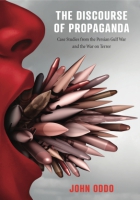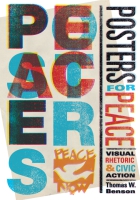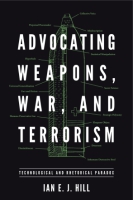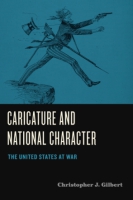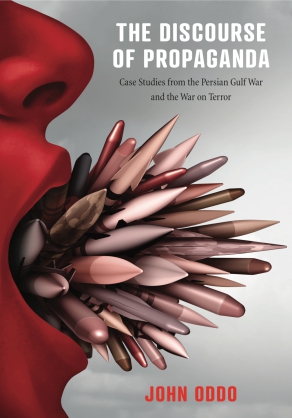
The Discourse of Propaganda
Case Studies from the Persian Gulf War and the War on Terror
John Oddo
The Discourse of Propaganda
Case Studies from the Persian Gulf War and the War on Terror
John Oddo
“John Oddo provides a much-needed theoretical update to the concept of propaganda. Central to his theory is recognition that propaganda involves an intertextual process that allows it to propagate—both vertically and horizontally—throughout society. His book provides valuable insights into the mechanisms of this propagation, showing how even unwitting actors contribute to its circulation. The discussion holds important implications for how we might immunize democratic discourse from the harms of manipulative rhetoric.”
- Description
- Reviews
- Bio
- Table of Contents
- Sample Chapters
- Subjects
Oddo argues that propaganda is more than just misleading rhetoric generated by one person or grou
p; it is an elaborate process that relies on recontextualization, ideally on a massive scale, to keep it alive and effective. In a series of case studies, he analyzes both textual and visual rhetoric as well as the social and material conditions that allow them to circulate, tracing how instances of propaganda are constructed, performed, and repeated in diverse contexts, such as speeches, news reports, and popular, everyday discourse.By revealing the agents, (inter)texts, and cultural practices involved in propaganda campaigns,
The Discourse of Propaganda shines much-needed light on the topic and challenges its readers to consider the complicated processes that allow propaganda to flourish. This book will appeal not only to scholars of rhetoric and propaganda but also to those interested in unfolding the machinations motivating America’s recent military interventions.“John Oddo provides a much-needed theoretical update to the concept of propaganda. Central to his theory is recognition that propaganda involves an intertextual process that allows it to propagate—both vertically and horizontally—throughout society. His book provides valuable insights into the mechanisms of this propagation, showing how even unwitting actors contribute to its circulation. The discussion holds important implications for how we might immunize democratic discourse from the harms of manipulative rhetoric.”
“Oddo's analysis of propaganda supporting recent US military actions reveals that the effect of propaganda lies in the intertextual uptake within social systems by which messages spread and transform, taking on their own viral life. By implication, the art of propaganda depends on understanding intertextually linked social systems, having the authority and power to activate those systems for replicating messages, locating diverse motives that will increase the spread, and designing messages that will reverberate in multiple systems. The appearance of social media now increases the visibility, rapidity, and intensity of these processes, making Oddo's analysis especially timely.”
“John Oddo's book takes great strides in political discourse studies, bringing together a wealth of rhetorical, sociopsychological, and critical linguistic approaches and applying them to decisive texts in the contemporary world. Exploring American discourses of the Gulf War and the War on Terror, he develops a new theory of propaganda, which provides a viable handle on several hitherto underresearched yet crucial aspects of propagandistic discourse, such as intertextuality and (forced) recontextualization.”
“In a period of fake news, troll factories, and WikiLeaks, John Oddo shows how propaganda circulates covertly, manipulates publics, and threatens democracy. Taking a novel approach in The Discourse of Propaganda, Oddo reveals the intertextuality of propaganda by studying some of the U.S. military’s most consequential campaigns in the Middle East.”
“John Oddo’s The Discourse of Propaganda is a timely and provocative follow-up to his elegant Intertextuality and the 24-Hour News Cycle (2014). Grounded in discourse analysis, the book is not only a powerful argument for reconsidering the concept of “propaganda” and a persuasive analysis of the role of propaganda in the Iraq invasion public discourse, but also a useful model for methodologically robust rhetorical analysis.”
“A timely and thoughtful challenge to our terrifying political misinformation culture that relies on numerous sophisticated modes of deception. John Oddo makes an important distinction between democratic civic rhetoric that fights for human rights and undemocratic propaganda that reinforces power. His detailed and convincing intertextual critical analyses demonstrate the dangers of war propaganda and reveal propaganda’s tragic consequences in human suffering.”
John Oddo is Associate Professor of English at Carnegie Mellon University and the author of Intertextuality and the 24-Hour News Cycle: A Day in the Rhetorical Life of Colin Powell’s U.N. Address.
Contents
AcknowledgmentsIntroduction: Approaching Propaganda with a Critical EyePart 1: Defining Propaganda and Historicizing America’s Wars in the Middle East1. Theorizing Propaganda: Intertextuality, Manipulation, and Power2. The Persian Gulf War and the War on Terror: A Brief HistoryPart 2: Manufacturing an Atrocity3. How the Incubator Story Became news: The Power of Performative Semiotics4. Keeping War Fever Alive: The Circulation of the Incubator StoryPart 3: Infiltrating Network News5. Message Force Multipliers: Rewarding Recontextualization6. Enacting and Entextualizing the Voice of the Expert7. The Evolution of a Talking PointPart 4: The Art of the Slogan8. “Support Our Troops” as Portable Text and Cultural Tradition9. “Support Our Troops” as Vertical and Horizontal PropagandaConclusion: War Propaganda and the Prospects for ResistanceAppendixesA Studying Discourse in ContextB Factors Facilitating Detachability and RecontextualizationC Data and Methods for Intertextual Analysis of the Incubator StoryD Transcript of Nayirah’s Performance at the HRCE Generic Components of George H. W. Bush’s Incubator AllegationsF Featured News Analysts and News BroadcastsG Incentives for Recontextualizing Pro-war and Pro-government ClaimsH Analysis of Speech Act VerbsI Recurring Themes in News Analyst DiscourseJ Themes Repeated by Analysts and Administration OfficialsK Reports About Aluminum Tubes in Classified Documents and Public DiscourseNotesBibliographyIndex
From the Introduction, “Approaching Propaganda with a Critical Eye”
“It is evident that a conflict exists between the principles of democracy—particularly its concept of the individual—and the processes of propaganda.”—Jacques Ellul, 1965
Regular readers of the New York Times could be forgiven for thinking propaganda is only a problem in foreign dictatorships. So-called rogue states and their propaganda campaigns have been the subject of several recent articles. For example, a 2015 op-ed alerts readers to a “new brand of authoritarian government” emerging in places such as Russia, Turkey, and Venezuela. What is striking about the “new autocrats,” the authors write, is that they use “hardly any violence”—instead preferring to “use propaganda, censorship, and other information-based tricks . . . to convince citizens of their superiority over available alternatives” (Guriev and Treisman 2015). Another recent article suggests how such dictatorial propaganda ought to be confronted by the United States. Specifically, the article is about the Voice of America (VOA), the official broadcast network of the United States overseas. This article warns that the VOA may be “floundering at the very moment when America needs to counter sophisticated propaganda” made by “countries like China and Russia and terrorist groups like the Islamic State” (Nixon 2015). In fact, a casual reading of articles since 2012 reveals that the Times overwhelmingly associates “propaganda” with authoritarian governments and terrorist groups in foreign countries. Meanwhile, America and the West are said to counteract this propaganda, typically by broadcasting the truth around the world.This Times coverage reflects how Americans typically understand propaganda. Indeed, the coverage hinges on two popular myths, one having to do with who is responsible for propaganda and the other having to do with what propaganda is like. The first myth is that propaganda only happens in totalitarian societies, where the State controls information and prohibits the expression of dissenting views. This myth ignores the fact that propaganda also flourishes in Western democracies— including the United States. Ironically, the existence of Western propaganda is illustrated by the Times articles themselves. After all, isn’t it strange that the leading newspaper in America consistently reports on propaganda as if it is unique to other countries? Isn’t this the kind of self-serving information used to “convince [American] citizens of their [government’s] superiority over available alternatives”?As Jacques Ellul (1965, 132) observes, propaganda is a fact of life in all democratic societies, largely because government officials rely on it to direct public opinion. According to Ellul, democratic governments do not follow popular will; they use propaganda to create popular will. “The point,” he writes, “is to make the masses demand of the government what the government has already decided to do.” Of course, “the government” is not the only propagandist involved in democratic society. Propaganda also comes from private corporations, think tanks, news agencies, advertisers, public relations firms—just about any elite institution aiming to influence public thought. Less obviously, ordinary citizens also shape how propaganda moves through a democracy. Citizens not only seek out propaganda, looking for ready-made news that can help them stay informed (144–46), but they also help spread propaganda, passing it along to one another and sometimes even pressuring one another to adhere to the prevailing truths of the day. As Huckin (2016, 118) writes, “Propaganda is indeed most effective when it is disseminated unconsciously by the broad public.”The second myth about propaganda is that it necessarily involves disinformation and chicanery, what the Times’s op-ed writers characterize as “information-based tricks.” In fact, a number of sources insist that propaganda uses specious rhetorical techniques—highly emotional words, deceptive representations, and logical fallacies inhibiting rational thought. Most famously, the Institute for Propaganda Analysis (IPA) published a list (1937) of seven common devices used by propagandists. To this day, the IPA list remains a popular tool for analysts who scrutinize offending texts for things like name-calling, testimonial, and “glittering generalities” (e.g., Marlin 2013; Mazid 2007). However, such inventories of technique have a major weakness: they will detect propaganda in just about any rhetorical act. For instance, in Martin Luther King Jr.’s (1963) written texts, one can find nearly all of the IPA’s propaganda devices. But few people would call King’s speeches and writings propaganda. For most of us, propaganda is not equivalent to a set of rhetorical techniques. Instead, techniques must be considered in context. Are they being used to sustain unequal power relations, or are they being used to call attention to historical injustices? Who is in power, and who stands to gain?It is also wrong to assume that propaganda always lies. Some does, but much propaganda is difficult to classify as true or false. (Take the slogan “Free Kuwait,” for example.) Other propaganda appears to be factual. It is a fact, for example, that in the 1980s, Iraqi president Saddam Hussein used illegal chemical weapons in a war against Iran. In 2002, this fact was repeated often by the U.S. government as it argued for removing Saddam from power. But such “truthful” assertions can still be misleading.Yes, Saddam used chemical weapons but only with American help: the U.S. government had not only supplied such weapons but had even helped Iraq locate Iranian targets (Borger 2002).No representation of reality is entirely complete or accurate—so propaganda can never attain the status of absolute truth. And while it is important to consider whether information is factual, an even more critical question for propaganda is whether it circulates widely and plays a dominant role in public discourse. After all, one essential characteristic of successful propaganda is that it propagates. Thus, those studying it should not only attend to the content of messages but also to how those messages spread, how they become mobile, durable, and repeatable. That is the premise of this book. Certainly, I am interested in deceptive rhetorical techniques and other forms of manipulation. But I am even more interested in what enables propaganda to circulate.On this question, there are two key points. First, propaganda is unlikely to circulate without an institutional and ideological infrastructure to support it. In an American context, this includes the infrastructure of private media—the routines and values of the corporate press, as well as the power relations that give some people access to channels of mass communication. Second, propaganda cannot circulate unless it is portable and detachable. Not every stretch of discourse is equally prone to circulation. Some discourse—for reasons that are formal, semantic, or cultural—will appear more worthy of being repeated. And good propagandists will use rhetorical strategies that induce recontextualization, prompting new audiences to further spread propaganda without altering or undermining it.
How I Conceptualize Propaganda
In this book, I aim to draw upon these observations to stitch together a theory of propaganda and to define those social and rhetorical characteristics that allow it to succeed. I can now state my argument a bit more formally as a set of three essential premises:• First, propaganda is an intertextual process that requires contributions from multiple agents. It can succeed in circulating only if it continually induces new audiences to recognize and recontextualize it on a mass scale. Importantly, the people who create and recontextualize propaganda exist in democracies as well as autocracies. They may be elite actors or ordinary people, powerful agents or “unwitting accomplices” (Huckin 2016, 129) who keep the propaganda alive.• Second, propaganda is manipulative without necessarily being false. Propaganda can include misleading rhetorical techniques and disinformation, but manipulation can take many other forms as well. Indeed, people may be manipulated simply because one truth becomes so dominant that other relevant truths are overwhelmed and obscured. In other words, propaganda may be accurate, factual, and logical—yet still hegemonic and therefore coercive.• Third, discourse best qualifies as propaganda if it harms the Many and serves the Few. We need not label as propaganda every case of mass-recontextualized discourse, even when that discourse includes so-called propaganda devices. No scholar refers to Martin Luther King Jr.’s speeches as propaganda precisely because these speeches contributed to a more just and equitable society. Propaganda, by definition it seems, works in the opposite direction: it consolidates the power of some groups while damaging the interests and well-being of other (typically less powerful) groups. This is true no matter who is spreading the propaganda or what their intentions might be.In support of this argument, this book examines cases of war propaganda, specifically domestic American propaganda used to justify the Persian Gulf War (1990–91) and the “Global War on Terror” (2001–present). With these case studies, I aim to clarify key functions of contemporary war discourse and illustrate the utility of theorizing propaganda as an intertextual process. I ask the following questions: What are the persuasive properties of war propaganda? What techniques are used to ensure a message will be heard, believed, and repeated by others? How is this propaganda kept alive in the media ecosystem? How are propaganda messages recontextualized in ways that ensure their continued viability?In answering these questions, this book helps uncover the mechanisms by which propaganda is circulated: the agents, texts, and cultural practices that allow a message to both persuade and proliferate. It reveals that propaganda is spread not just by politicians and news organizations but also by interest groups, corporations, and ordinary citizens, who wittingly or unwittingly keep the propaganda alive. In addition, the book firmly ties propaganda to current notions of intertextuality and emphasizes how makers of propaganda signal that their discourse is detachable and repeatable, inducing people to recontextualize the propaganda in new contexts and for new audiences. Finally, the book draws attention to an issue of critical importance: propaganda’s threat to democracy. Indeed, this book raises serious questions about the degree to which American citizens can meaningfully participate in democratic politics, especially those politics that have thrust the country into a state of perpetual war.My Goals for This BookAs Jowett and O’Donnell (2015, 1) report, propaganda has been studied in many disciplines: history, journalism, political science, psychology, rhetoric, and communication. I hope to contribute new knowledge to scholars in all these areas, though I approach propaganda from my position in the field of critical discourse studies (CDS). Curiously, in CDS, propaganda has received relatively little attention, despite the field’s stated interest in discursive power abuse and illegitimate forms of persuasion. In fact, a search of the top journals publishing CDS reveals that very few articles include “propaganda” in their titles or keywords. And the articles that do refer to propaganda generally fail to define the term, let alone offer a theory for it.However, CDS does offer a number of valuable concepts that can inform how propaganda is understood, concepts such as manipulation (Van Dijk 2006), textual silence (Huckin 2002, 2010), mediation (Chouliaraki 2006; Graham 2004), legitimation (e.g., Van Leeuwen 2007; Cap 2006), and intertextual reproduction (Dunmire 2011; Fairclough 1995; Hodges 2011). While these concepts bear a crucial relationship to propaganda, none is identical to it. My goal, then, is to build upon insights from CDS (and discourse studies more generally) to develop an explicit definition of propaganda. Though my definition is motivated by critical theories of language and power, it should be of interest to anyone studying propaganda.A related goal of this book is to suggest different methods for propaganda analysis. Several studies of propaganda fix upon a single text—say, a political ad or a presidential oration (e.g., Mackay 2015; Mazid 2007). While such focused research can be enlightening, I think it overlooks the intertextual character of propaganda. Indeed, by treating propaganda as an intertextual process, I am strongly suggesting that it ought to be studied intertextually. Propaganda does not happen in one discrete (con)text. Instead, by definition, successful propaganda spreads out across many texts and contexts. Such an understanding of propaganda requires that we pay greater attention to enduring media campaigns rather than short-lived discourse moments. As Carvalho (2008, 164) suggests, “Most studies of media discourse are like snapshots examining some news items in detail but covering a short time span. . . . While this may be relevant for some events, most public issues have a significantly long ‘life,’ which is tied to representations in the media.” An intertextual focus allows us to examine how dominant meanings develop over time and how stories, themes, and slogans are recontextualized again and again—so often and so widely that they become recognizable as propaganda. By looking beyond individual texts, we also gain insight into the more persistent (and typically more significant) efforts to manipulate popular consciousness. We observe how meanings both emerge and remain viable in media ecosystems, sustaining public attention and potentially securing consent for illegitimate practices.[Excerpt ends here.]
Also of Interest
Mailing List
Subscribe to our mailing list and be notified about new titles, journals and catalogs.
